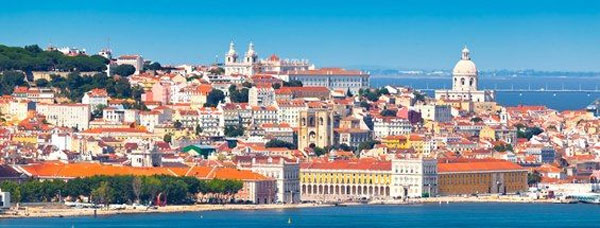Reply To:
Name - Reply Comment

One of the most definitive features of the Portuguese cultural landscape is Fado. And Lisbon is immersed in this long-standing musical art form that is said to have originated in the early 19th Century in the streets of the city. The essence of the music is something locals call ‘saudade’, with no literal translation, it refers to the nostalgia, melancholy and longing present in the tone and content of the music. Fado houses dot Lisbon’s cityscape and one can also see Fadistas performing in the streets. The district of Alfama is home to the Fado Museum for those who wish to discover more about its musical heritage.
Historic structures and districts are also abundant, but none more renowned than Belém Tower. Almost as old as the city itself, the Tower was the staging point for many a voyage during Portugal’s Age of Discovery, and is a favourite among visitors. One of the best places to see Lisbon is from a sidewalk café in one of its many bairros, or districts. There are hidden gems to be discovered in the quaint alleyways of the Medieval District or along the ultra-trendy Avenida da Liberdade.
Artistic treasures are nestled away in a number of intimate but impressive museums and galleries in Lisbon, including the Calouste Gulbenkian collection, which boasts works of Rembrandt and Renoir, among others.
Shopping and Entertainment
When it comes to fashion and entertainment the options are plentiful. From international brands and local designers, to bars, cafés and Fado houses, the Bairro Alto, Chiado and Principe Real districts are known for their local boutiques, eateries and more.
Along with its very popular Fado houses, Bairro Alto’s mix of 16th Century and bohemian charm is a favourite amongst writers and artists. Because of its trendy bars and avant-garde afterhours fashion shops, many consider it the epicentre of Lisbon’s vibrant nightlife. Here, a visit to the Miradouro de São Pedro de Alcântara garden terrace is highly recommended for a breathtaking view of the city.
The discerning traveller will enjoy Chiado’s art nouveau jewellery, bookstores, porcelain shops and cosy cafés. This district features the centuries-old Tavares Rico Restaurant, established in 1784, as well as an outlet for one of Portugal’s most well-known designers, Ana Salazar. To discover Lisbon’s interior design, antique offerings and historical architecture, Principe Real is the place to explore.
No visit to Lisbon would be complete without a stroll down Avenida da Liberdade. Popular for its luxury fashion brands, this leafy boulevard is also an important theatre district and home to several outstanding architectural works.
There are many festivals to be enjoyed throughout the year in Lisbon, from literary events and musical concerts to culinary celebrations and fashion expos. Lisbon Fashion Week is the main event in winter, the Fish and Flavours Festival is one of the highlights in spring and summer features music and street festivals, including the Festas de Lisboa, while film festivals, like the Estoril International Film Festival, dominate the fall.
Cuisine and leisure
Being a coastal city, seafood figures highly in Lisboan cuisine. Fish and shellfish feature in many dishes, including the national dish, bacalhau, which is dried salted codfish. Sardines and horse mackerel are the principal ingredients in Caldeira stew, and rice complements a mixture of crab, lobster, oysters and shrimp called arroz de marisco. Another popular national dish known as cozida å portuguesa features meat rather than seafood and is made with a variety of meats. It’s recommended you start your foray into Portuguese fare at well-known restaurants like Lisboa å Noite or Cerevejaria Trinidade.
Follow up a hearty meal with a trip to the beaches at Cascais and Estoril, small resort towns known for mild temperatures and ideal surfing conditions. For a more active excursion, visit Belém Tower, the most iconic site in Lisbon and the location from which many exploratory missions were launched since its construction in the 1500’s. There are many museums housing fine art, as well as the more recent innovation, the Design and Fashion Museum.
Beyond Lisbon
Lisbon is surrounded with picturesque villages and locales, including the breathtaking Sintra just under an hour outside Lisbon. This hilly town is known for it’s storybook landscape boasting beautiful palaces and castles, the most famous of which is Pena Castle. Surrounded by beautiful gardens, it was built in the mid-1800’s. The medieval beauty of Obidos led to its allocation as a national monument. Its romantic history makes it all the more alluring as the town itself was a wedding gift bestowed upon a Queen by her King in the late 1200’s. It has maintained its ancient charm and even hosts an annual Medieval Fair during the summer.
Other attractive destinations include Setubal, popular for dolphin watching, Ericeira, another haven for surfers as well as many other palaces, historic towns and world heritage sites that offer breathtaking examples of Portuguese heritage and life.
On every Emirates flight to Lisbon, luxury and comfort await you with over 600 channels of on-demand entertainment, gourmet cuisine and award-winning service. Enjoy First Class flat-bed relaxation, comfortable Business Class seating, a spacious Economy Class cabin and convenient seatback electronic communication in all classes on Emirates flights to Lisbon.